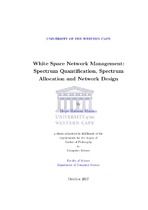| dc.contributor.advisor | Bagula, Antoine | |
| dc.contributor.author | Mauwa, Hope Rabson | |
| dc.date.accessioned | 2018-08-02T09:29:44Z | |
| dc.date.available | 2018-08-31T22:10:06Z | |
| dc.date.issued | 2017 | |
| dc.identifier.uri | http://hdl.handle.net/11394/6171 | |
| dc.description | Philosophiae Doctor - PhD (Computer Science) | |
| dc.description.abstract | The unused spectrum in the television broadcasting frequency bands (so-called TV
white spaces) can alleviate the spectrum crunch, and have potential to provide
broadband connection to rural areas of countries in the developing world. Current
research on TV white spaces focuses on how to detect them accurately, and how they
can be shared or allocated to secondary devices. Therefore, the focus of this research is
three-fold: to investigate a novel distributed framework, which does not use
propagation models in detecting TV white spaces, and suitable for use in countries of
the developing world; to investigate a suitable spectrum sharing mechanism for
short-time leasing of the TV white spaces to secondary devices; and extend the
research to investigate the design of a TV white space-ware network in TV white space
frequencies. | |
| dc.language.iso | en | |
| dc.publisher | University of the Western Cape | |
| dc.title | White Space Network Management:
Spectrum Quanti cation, Spectrum
Allocation and Network Design | |
| dc.rights.holder | University of the Western Cape | |

